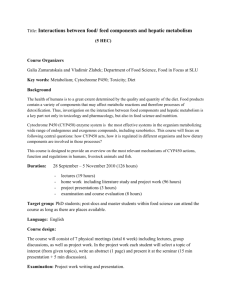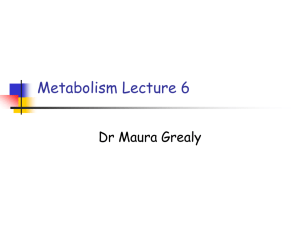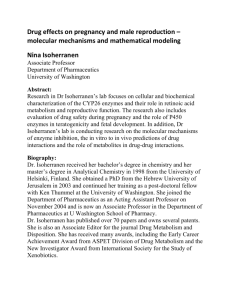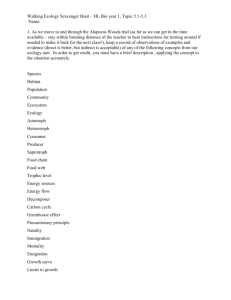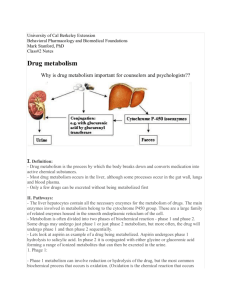File
advertisement
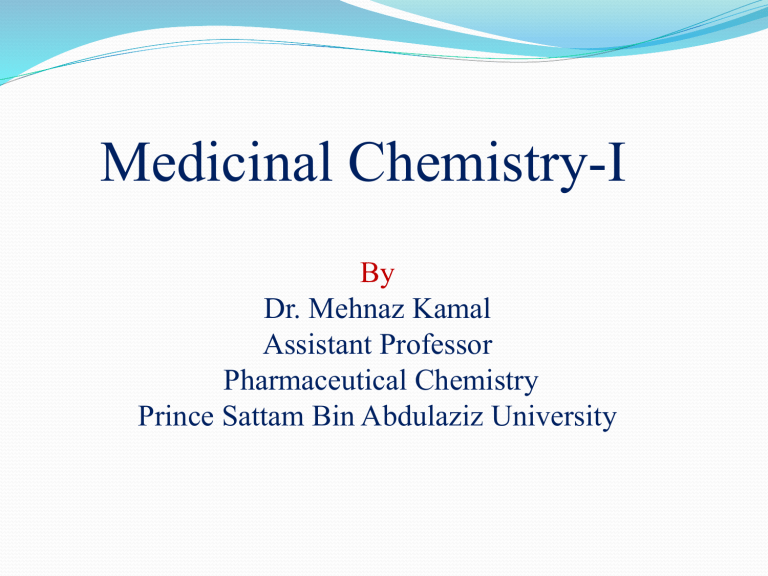
Medicinal Chemistry-I By Dr. Mehnaz Kamal Assistant Professor Pharmaceutical Chemistry Prince Sattam Bin Abdulaziz University DRUG METABOLISM The Fate of a Drug DOSE Pharmaceutics ABSORPTION MOST TISSUES PROTEIN BOUND NONSPECIFIC BINDING PLASMA FREE DISTRIBUTION BIOPHASE ELIMINATION METABOLISM RECEPTOR BINDING RENAL EXCRETION EFFECT Pharmacokinetics Pharmacodynamics Drug at site of administration 1. Absorption Drug in plasma 2. Distribution Drug/metabolites 3. Metabolism in tissues Drug/metabolites in urine, feces, bile 4. Elimination BIOTRANSFORMATION/METABOLISM OF DRUGS Chemical modification of drugs compounds (xenobiotics) in the body. or foreign The apparent function of drugs or xenobiotics metabolism is their transformation into watersoluble derivative which can be easily eliminated via renal route. Effect of drug metabolism Active drug Inactive prodrug Inactive Drug Metabolic activation Active drug Inactive metabolite Lipid Solubility R-H R-OH Chemical hook Drug metabolism reactions traditionally have been regarded as detoxification processes. However, it is incorrect to assume that drug metabolism reactions are always detoxifying. It is becoming increasingly clear that not all metabolites are nontoxic. Many toxic side effects of drugs and environmental contaminants can be attributed directly to the formation of chemically active metabolites that are highly detrimental to the body. Implications For Drug Metabolism 1. Termination of drug action 2. Activation of prodrug 3. Bioactivation and toxication 4. Carcinogenesis The objective of studying drug metabolism is to make medicinal chemists aware of the chemical processes involved in the biotransformation of drugs and to encourage them to further study so as to be able to use the acquired knowledge in the design of new more safe drugs. Two categories of xenobiotics are not or are hardly subject to metabolic transformations : 1- Hydrophilic compounds (e.g. saccharine, strong acids or bases) O O S NH O 2- Highly lipophilic polyhalogenated xenobiotics such as some insecticides e.g. DDT. Innumerable examples exist of metabolic reactions not leading to inactivation and detoxication. Some metabolite will possess its own activity which will be similar to or different from that of the parent drug. Other metabolites may be highly reactive entities able to bind covalently to soluble or membrane proteins, enzymes, or even DNA (mutagenic and carcinogenic compounds). Lethal synthesis: a classic example of lethal synthesis is provided by the metabolic conversion of the nontoxic insecticide parathion into its oxygenated isostere paraoxon, a potent acetylcholinesterase inhibitor OEt O2N O-P-OEt OEt O2N O-P-OEt S Parathion O Paraoxon Fig.2. Metabolic conversion of the nontoxic insecticide parathion to paraoxon Major Sites of Metabolism Drug metabolism can occur in every tissue (e.g. gut, lung, kidney). However, the major drug metabolizing enzymes (DMEs) are expressed at the highest levels in the liver, which serves as the major organ of metabolic clearance High liver Medium lung, kidney, intestine Low skin, testes, placenta, adrenals Very low nervous system Extrahepatic microsomal enzymes (oxidation, conjugation) Hepatic microsomal enzymes (oxidation, conjugation) Hepatic non-microsomal enzymes (acetylase, sulfate transferase, GSH S-transferase, alcohol/aldehyde dehydrogenase, hydrolase, oxidase/reductase) The LIVER is the chief organ for drug metabolism because: – The blood flow through the liver is high – Hepatocytes contain numerous metabolic enzymes Biotransformation broadly classified into two types of reactions: – PHASE I: Functionalization reaction, new polar groups such as CO2H, OH or NH2 are introduced or unveiled/unmasked from pre-existing functions through oxidative, reductive or hydrolytic reactions. – PHASE II: known as conjugation reactions, link an endogenous solubilizing moiety either to the original drug (if polar functions are already present) or to the phase I metabolite. Phase I H Phase II OH O.SO3H Fig. 1. A phenyl ring in a xenobiotic first undergoes a functionalization reaction (phase I) and is then conjugated (phase II) Phase I or Functionalization Reactions 1- Oxidation electron removal, dehydrogenation and hydroxylation. 2- Reduction electron addition, hydrogenation and removal of oxygen 3- Hydrolytic reactions/Hydrolysis Oxidation Reduction • hydroxylations aromatic, aliphatic, nitrogen • dealkylations(N-, S-, P) • deaminations • N-, S-, P- oxidations oxidoreductases • S-replacements oxidases monoamine oxidases • epoxidations mixed function oxidases • others • • • • azo reduction nitro reduction disulfide reduction others oxidoreductases reductases esterases Hydrolysis • esters • amides amidases peptidases lipases 1. Oxidation reactions The great majority of these oxidations are carried out by the haemoprotein cytochrome P450 which is embedded within the phospholipid environment of the microsomes derived from the endoplasmic reticulum of living cells. Cytochrome P450 (CYPs) • Cytochrome P450 is a family of enzymes located in the endoplasmic reticulum of liver. •When liver is homogenized and biochemically fractionated these enzymes are found in the microsomal fraction (small closed ER membrane fragments). Thus these enzymes are called microsomal enzymes. Cytochrome P450 enzymes perform many of the most important biotransformation reactions. These enzymes oxidize a wide variety of compounds foreign to the body. There are at least 18 different forms of cytochrome P450 identified in humans, produced by different genes. 60% of drugs are metabolized primarily by CYPs. • Important cytochrome P450 enzymes: 1. CYP3A4. 2. CYP1A2. 3. CYP2C. 3. CYP2D6. • Individual enzymes differ in their substrate specificity and regulatory properties. The reaction sequence illustrated by CyP Redox Cycle : CYP450 Reaction Sequence OH DRUG DRUG CYP450 Fe3+ CYP450 Fe3+ CYP450 Fe3+ DRUG DRUG NADPH + OH CYP450 Fe3+ H+ e- CYP450 reductase CYP450 Fe2+ NADPH + H+ DRUG : O .. DRUG H+ eH2O CYP450 Fe2+ O2 CYP450 Fe2+ DRUG DRUG O21- R-H + O2 + 2e- + 2H+ O2 R-OH + H2O oxidation C • hydroxylations aromatic, aliphatic, nitrogen • dealkylations (N-, S-, P-) • deaminations • N-, S-, P- oxidations • S-replacements • epoxidations • others C H OH N N N N H O OH O CONH2 O C C C CONHOH C P P O C S C O O O S S O O C S C S Si H Si OH Fig. 4. Major reactions of oxygenation catalyzed by cytochrome P450. 1.1. Carbon oxidation reactions/ C-oxidation reactions The reactions of C-oxidation represent the common metabolic attacks on xenobiotics. a) Hydroxylation of saturated aliphatic carbon atoms – In practice a non-activated alkyl group undergoes mainly and -1 oxidation Oxidation occurs at the terminal methyl group -1 oxidation occurs at the carbon atom next to the last one (penultimate carbon atom) n C3H7 H2 C HO H2C H3C COOH 5-Hydroxyvalproic acid n C3H7 H2 C CH C H2 Oxidation CH C H2 COOH Oxidation Valproic acid n C3H7 OH CH H3C CH C H2 COOH 4-Hydroxyvalproic acid Fig. 5: and 1Oxidation nC3H7 H2 C HOOC CH C H2 COOH 2-n-Propylglutaric acid Cyclic aliphatic systems are usually hydroxylated on the least-hindered or most-activated carbon atoms O HN O O SO2 HN N H O SO2 N H Fig. 6: Hydroxylation on cyclic aliphatic system OH b) Hydroxylation at activated SP3 carbon atoms OH R R OH OH OH R X O R R XH + X X = O, N-R, S Fig. 7: Hydroxylation at activated SP3 carbon atoms N CH3 Br N HCHO CHCH2CH2N H Br CHCH2CH2N CH3 N HCHO H Br CHCH2CH2N CH3 Desmethyl bromopheniramine Bromopheniramine H Bisdesmethyl bromopheniramine NH3 N N Br CHCH2COOH 3-(p-Bromophenyl)-3-pyridylpropionic Br CHCH2CH2OH 3-(p-Bromophenyl)-3-pyridylpropanol Fig. 8: Oxidation of carbon atoms to heteroatom The final result is dealkylation when a secondary or tertiary amine loses an alkyl substituent, and deamination when the substrate loses an amino group Aromatic ethers undergo a similar hydroxylation, followed by hydrolysis of the hemiacetal to a phenol and aldehyde O H N O O H H N N + CH3CHO O OH O OH Fig. 9: Oxidative O-dealkylation of phenacetin yields paracetamol Dealkylation reactions can also result from direct oxidation of the heteroatom (N,S) as opposed to that of the -carbon. Dehalogenated carbonyl compounds are formed which may lead to toxic reactions. c) Oxidation attack on unsaturated aliphatic systems Carbon-carbon double bonds undergo metabolic epoxidation to the corresponding epoxide, an alkylating metabolite which can, for example, alkylate nucleic acids H C O CH2 GSH Styrene Mercapturic acid derivative Styrene Oxide Covalent binding to proteins and nucleic acid OH OH O HO HO Fig. 11: Epoxidation of Styrene and diethylstilbesterol Carbon-Carbon insertion yields heterolytic C-O highly reactive covalently to the triple bonds, oxygen an oxirene which opens by bond cleavage to form a intermediate which binds enzyme. d) Hydroxylation of aromatic rings R OH R Arenols H2O R R OH Trans-Dihydrodiols OH R Arene o GSH Arene Oxide OH Glutathione Adducts GS R M Macromolecular Adducts OH M Fig. 13: Possible reaction pathways for arene oxides As a rule, hydroxylation occurs on the lesshindered site, usually the para- position. Electronic factors are also operative. This can be seen in the following representative examples: O NH-CO-CH3 7 S OH 3 N Cl N Acetanilide Chlorpromazine 7 O O Warfarin 1.2. N-oxidation reactions –Tertiary aliphatic amines are usually oxidized to the corresponding N-oxides, but the reaction is strongly affected by steric hindrance. O CH 3 M CH 2 CH N M CH 2 CH CH 3 R N CH 3 CH 3 R –Secondary and primary amines are N-oxygenated to hydroxylamines, the intermediate is believed to be an N-oxide. H N R R H O O N N R R H R R Methaemoglobinaemia toxicity caused by several aromatic amines, e.g. Dapsone, is attributed to their bioconversion to the corresponding N-hydroxy derivative RHN SO2 NH2 Dapson R = H N-Acetyldapson R=CH3CO RHN SO2 NHOH N-Hydroxy derivatives Amides can be N-oxygenated to hydroxylamides. The overdose toxicity of Acetaminophen/Paracetamol has been attributed to NAPQI (N-acetyl-p-benzoquinone imine). 1.3. S-oxidation reactions S-Oxidation constitutes an important pathway in metabolism of the H2-histamine antagonist, Cimetidine. The corresponding sulfoxide derivative is the major metabolite. S HN N H N H N N S HN C N N O H N H N N C N Sulfoxide drugs and metabolites (e.g. those of phenothiazines) may be further oxidized to sulfones (-SO2-). 2. Reduction reactions It is a major route of metabolism for aromatic nitro and azo compound as well as for a wide variety of aliphatic and aromatic N-oxides which are reduced to tertiary amines. From a quantitative point of view, reduction reactions are less important than oxidations since the human organism is mostly an aerobic one. 2.1. Reductions at carbon atoms The major reactions of reduction at carbon atoms can be illustrated by the following scheme R1 C R1 C R2 R1 OH O C R2 R2 R3 R1 C H R3 CH CH C R4 O R2 C R4 O 2.2. Reductions at other atoms Various reactions of N-oxidation are reversible, Cyt P450 and other reductases being able to deoxygenate N-oxides back to amine. CH3 R N R N O CH3 CH3 Ar Ar NO2 Ar NO O Ar N N Ar Ar = Aryl Ar CH3 N N Ar Ar NHOH H H N N Ar Ar 2 Ar NH2 NH2 Other reductions involve sulfur and a few other atoms. Thus, disulfides are reduced to thiols, and there are numerous examples of the reduction of sulfoxides to sulphides e.g. sulindac to sulindac sulfide. R1 S S R2 R1 SH + HS R1 S R2 R2 R1 S O R2 CH2CO2H F CH2CO2H F CH3 CH3 H H H3C S O H3C S 3. Hydrolytic reactions/ Hydrolysis The vast majority of esters and amides may be hydrolyzed in the animal body, the extent and rate of hydrolysis being dependent upon the chemical reactivity of the functional group. Hydrolysis or hydrolytic cleavage are catalyzed by esterases, peptidases or other enzymes, but nonenzymatic hydrolysis is also known to occur for sufficiently labile compounds under biological conditions of pH and temperature. R1 R2 R1 CO2H ONO2 R OH CONH R2 R1 CO2 R R1 + R2 OH R2 NH2 + HNO 3 CO2H + Esterase Reactions: e.g. aspirin (others include procaine, clofibrate) CO 2 H OCOCH 3 CO 2 H OH Esterase Amidase Reactions: e.g. lidocaine (others include peptides) O N N H Amidase OH N O + NH2
